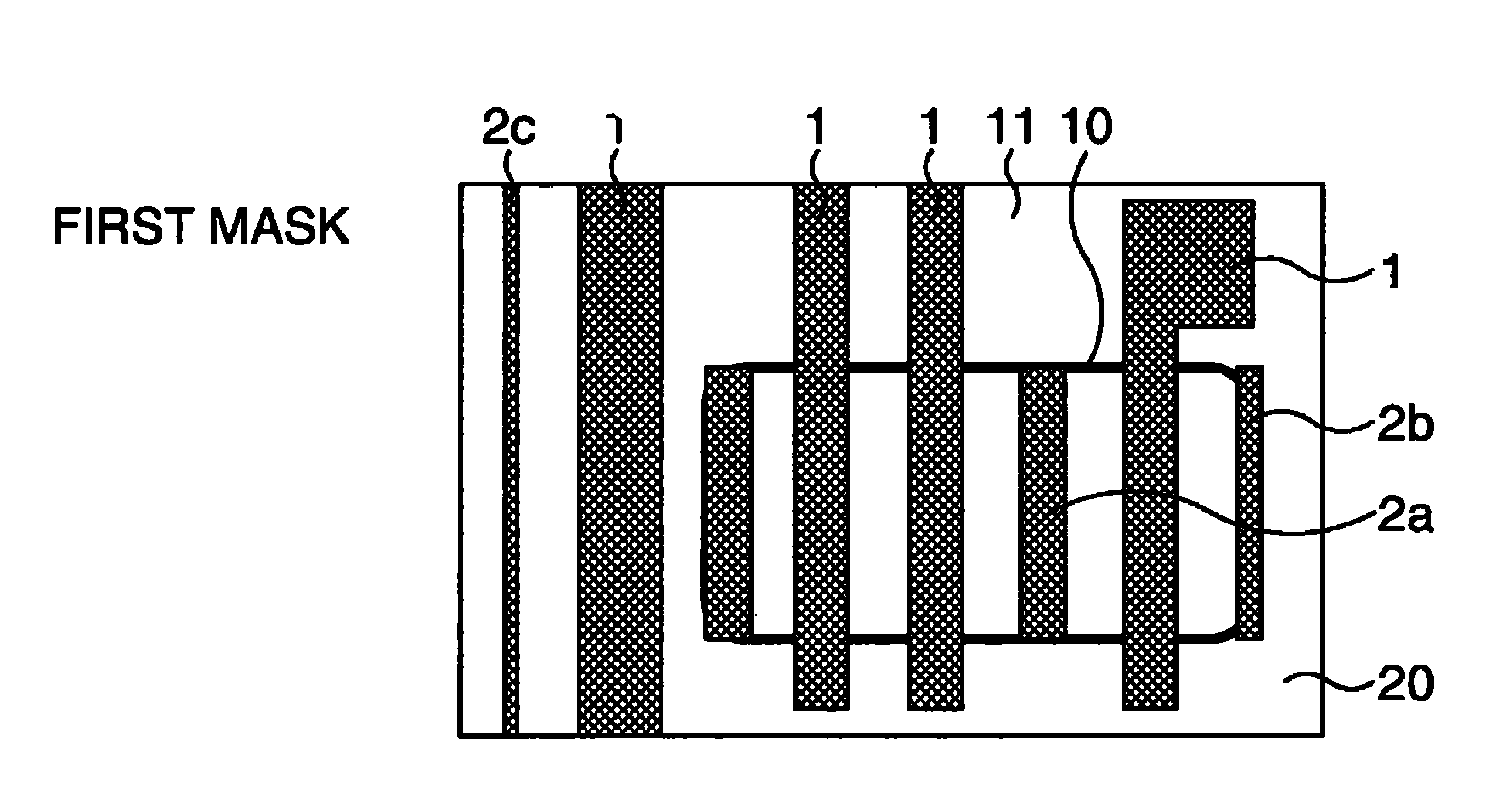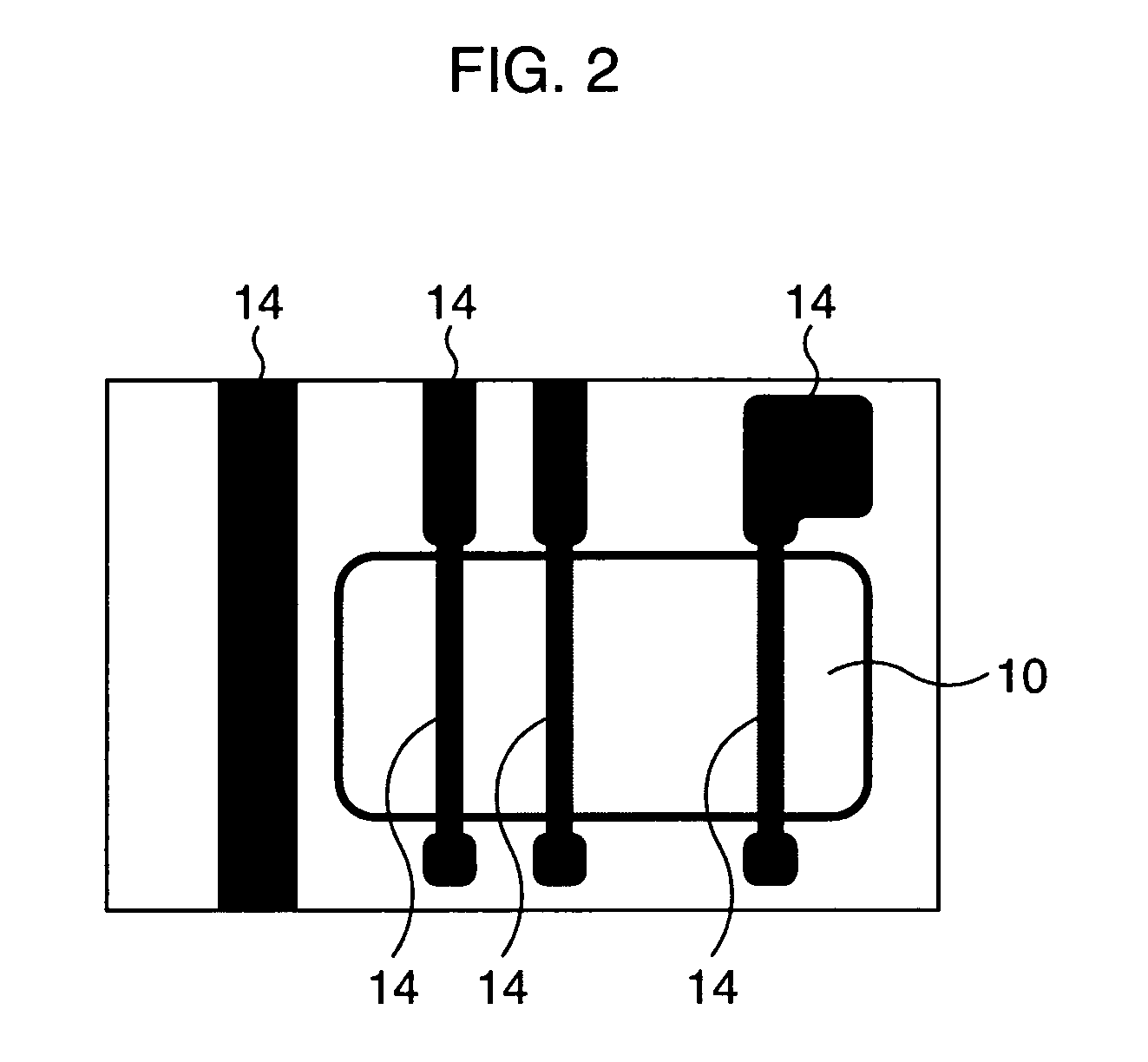Photomask and manufacturing method of semiconductor device
a manufacturing method and semiconductor technology, applied in the field of photomasks and semiconductor device manufacturing methods, can solve the problems of difficulty in forming fine patterns and fine pitches, depth of focus, phase edge technique of forming such fine patterns has a problem, etc., and achieves high reliability and uniform line widths. , the effect of high-quality semiconductor devices
- Summary
- Abstract
- Description
- Claims
- Application Information
AI Technical Summary
Benefits of technology
Problems solved by technology
Method used
Image
Examples
first embodiment
[0028]FIG. 1A to FIG. 1C are schematic plan views for explaining a manufacturing method of a semiconductor device including a gate according to the first embodiment. Here, an explanation will be given with a particular emphasis on a process of forming gate patterns by a phase edge technique.
[0029]A first photomask 11 is a halftone phase shift mask (for example, a transmittance of 6%) for an ArF excimer laser as shown in FIG. 1A. This photomask 11 includes gate patterns 1 to form gates and assist patterns 2a, 2b, and 2c to be inserted into portions in each of which a distance between the gate patterns 1 is large. Here, the assist pattern 2a has a shape corresponding to only a position of an active region 10 to be exposed, the assist pattern 2b is formed to have a resoluble line width, which is different from the assist pattern 2a, and these assist patterns 2a and 2b have each a line width optimized according to the line widths of and space width between the respective gate patterns 1...
second embodiment
[0043]FIG. 4A to FIG. 4C are schematic plan views for explaining a manufacturing method of a semiconductor device including a gate according to the second embodiment. Here, an explanation will be given with a particular emphasis on a process of forming gate patterns by the phase edge technique.
[0044]A first photomask 21 is a halftone phase shift mask (for example, a transmittance of 6%) for an ArF excimer laser as shown in FIG. 4A. This photomask 21 includes gate patterns 1 to form gates and assist patterns 23 each having a line width equal to or smaller than a resolution limit which are to be inserted into portions in each of which a distance between the gate patterns 1 is large. Here, all the assist patterns 23 have the same width, for example, from approximately 50 nm to approximately 60 nm on the wafer substrate 20.
[0045]A second photomask 22 is a Levenson phase shift mask for the ArF excimer laser as shown in FIG. 4B. The photomask 22 includes shifter patterns 3 corresponding t...
third embodiment
[0051]FIG. 5A to FIG. 5C are schematic plan views for explaining a manufacturing method of a semiconductor device including a gate according to the third embodiment. Here, an explanation will be given with a particular emphasis on a process of forming gate patterns by the phase edge technique.
[0052]A first photomask 31 is a halftone phase shift mask (for example, a transmittance of 6%) for an ArF excimer laser as shown in FIG. 5A. This photomask 31 includes gate patterns 1 to form gates and assist patterns 24a, 24b, and 24c to be inserted into portions in each of which a distance between the gate patterns 1 is large. Here, a narrow-width portion of the assist pattern 24a is formed to have a line width equal to or smaller than a resolution limit, a wide-width portion thereof is formed to have a resoluble line width, the assist pattern 24b is formed to have a resoluble line width which is different from the assist pattern 24a, and these assist patterns 24a and 24b respectively have li...
PUM
| Property | Measurement | Unit |
|---|---|---|
| transmittance | aaaaa | aaaaa |
| thickness | aaaaa | aaaaa |
| thickness | aaaaa | aaaaa |
Abstract
Description
Claims
Application Information
 Login to View More
Login to View More - R&D
- Intellectual Property
- Life Sciences
- Materials
- Tech Scout
- Unparalleled Data Quality
- Higher Quality Content
- 60% Fewer Hallucinations
Browse by: Latest US Patents, China's latest patents, Technical Efficacy Thesaurus, Application Domain, Technology Topic, Popular Technical Reports.
© 2025 PatSnap. All rights reserved.Legal|Privacy policy|Modern Slavery Act Transparency Statement|Sitemap|About US| Contact US: help@patsnap.com



